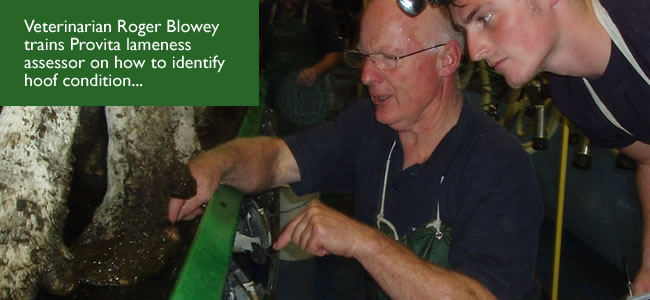The following article appeared in Farming Life, Sat 29th October, 2011.
DairyCo figures have highlighted that a quarter of the British dairy herd is lame at any one time, costing farmers an average of £180 per case through lost milk sales, treatments and reduced activity. Traditionally around 25% of all lameness has been associated with digital dermatitis. As everyone knows, this is an infectious condition that can spread quickly through the herd, producing painful lesions on the soft tissues between the claws and the heel. Cows often walk tenderly on the affected feet, sometimes giving the impression that they are walking on ‘tip toes’ in order to avoid touching the ground with the painful area of the hoof.
Last week, as part of a training session for their newly recruited lameness assessors, locally based natural animal health company, Provita, which is recognised among the farming community for their leading footbathing solution, Hoofsure Endurance, spent two days with renowned vet Roger Blowey (FRCVS).
The Provita team were inquisitive as to why cows seemed to be walking on their ‘tip toes’ and how digital dermatitis can impact this. It was explained that a cow with digital dermatitis will naturally walk on her toes to reduce pain on her heel. This is well illustrated in the book, “Cattle Lameness and Footcare” which was nicknamed by one of the new recruits as his ‘hoofcare survival guide’ on foot conditions. This explains that the incidence of new digital dermatitis infected hoof lesions seems to be higher in herds where digital dermatitis is poorly controlled, and can often result in total amputation of the digit.
R.Blowey also wrote to the Vet Record in August 2011 pointing that there is increasingly more evidence to suggest a secondary involvement of digital dermatitis. What is especially interesting about digital dermatitis is that over the past few years the disease has changed. In addition to causing infections of the skin, the bacteria have now moved onto the hoof, and are associated with non healing hoof lesions such as toe necrosis, ‘wall ulcers’ and non-healing sole ulcers. The reason for this change in disease pattern is unknown, but the change has been noted in several different countries around the world at the same time, and highlights that a major shift is now required in our approach to the control of infectious causes of lameness on farm. This emerging welfare issue will have huge ramifications for farmers.
Provita Technical Advisor, Tommy Armstrong also emphasised, “Secondary effects of digital dermatitis mean that preventative footbathing is no longer optional but critical! Our lameness assessors have been professionally trained and farmers can make use of this service by contacting Provita on 07720101444.
